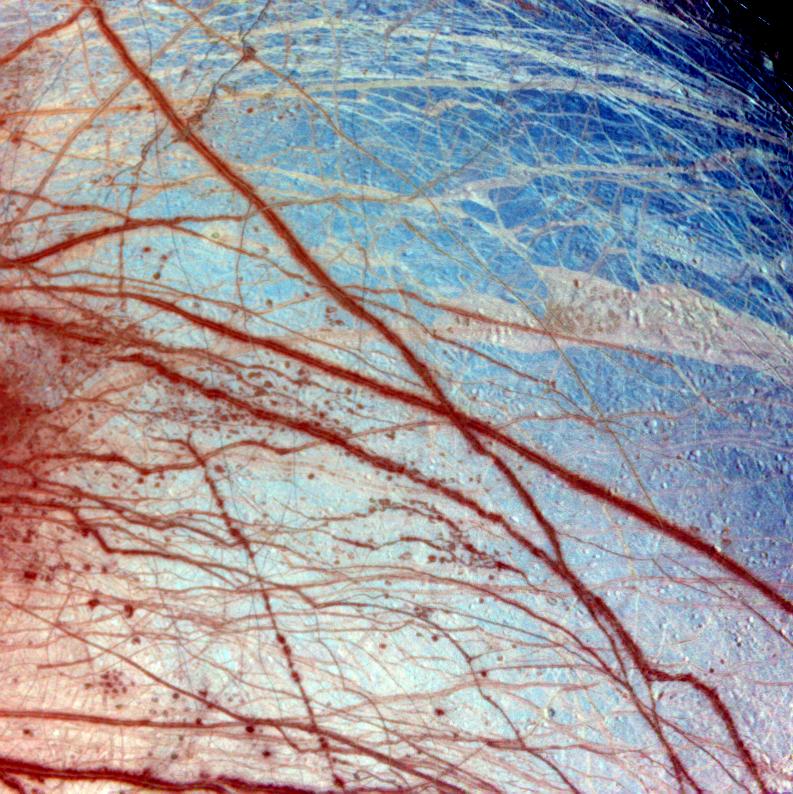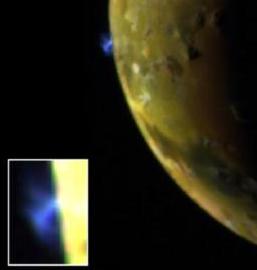 Recent observations with HST reveal that Europa has a very tenuous atmosphere
(1e-11 bar) composed of oxygen. Of the 61 moons in the solar system only four others
(Io, Ganymede, Titan and Triton) are known to have atmospheres. However, unlike
the oxygen in Earth's atmosphere, Europa's is almost certainly not of biologic
origin.
It is most likely generated by sunlight and charged particles hitting
Europa's icy surface producing
water vapor which is subsequently split into hydrogen and oxygen. The hydrogen
escapes leaving the oxygen.
Recent observations with HST reveal that Europa has a very tenuous atmosphere
(1e-11 bar) composed of oxygen. Of the 61 moons in the solar system only four others
(Io, Ganymede, Titan and Triton) are known to have atmospheres. However, unlike
the oxygen in Earth's atmosphere, Europa's is almost certainly not of biologic
origin.
It is most likely generated by sunlight and charged particles hitting
Europa's icy surface producing
water vapor which is subsequently split into hydrogen and oxygen. The hydrogen
escapes leaving the oxygen.
Europa has a weak magnetic field (perhaps 1/4 of the strength of Ganymede's). This is very strong evidence that there is a conducting material beneath Europa's surface, most likely a salty ocean. After Earth and Mars, Europa does appear to be the best place to look for evidence of past or present life! Indeed, if Jupiter were to become a very cool star (Europa is 100x closer to Jupiter than Earth is to the Sun!), it might likely warm Europa's surface, evolving it into an ocean planet.
 Io (0.4 Million km from Jupiter)
Io (0.4 Million km from Jupiter)
Recent data from Galileo indicates that Io has a core of iron
(perhaps mixed with iron sulfide) with a radius of at least 900 km,
making it similar in bulk composition to the terrestrial planets.
However, Io's surface is radically different from any other body in the solar
system. It came as a very big surprise to the Voyager scientists on the
first encounter. They had expected to see impact craters like those on
the other terrestrial bodies and from their number per unit area to
estimate the age of Io's surface. But there are very few, if any, impact
craters on Io (left). Therefore, the surface is very young.
 What's happening on Io?
What's happening on Io?
Io has the youngest surface in the
Solar System. Present estimates are that it is so active
geologically that its surface is completely redone on a timescale
of about a million years. Io is the most active object geologically in
the Solar System. In addition to the intense volcanic activity, Io's
surface is being continuously eroded by a bombardment of
charged particles trapped in Jupiter's magnetic field.
 The source of this geological activity is the tidal effect of Jupiter
on Io as it orbits the giant planet. These tidal forces are so large
that Io's surface is pulled upwards and downwards by hundreds
of meters in each rotation. Just like bending a paper clip heats
it, these tidal distortions keep much of the interior of Io in a
molten state. Thus, Io is a thin crust (primarily of sulfur) sitting
on a molten interior. It is this molten interior breaking through
to the surface that produces the volcanos of Io. Perhaps because
of Jupiter's initial heat during formation, boiling off light elements
from Io, Io appears to have no water whatsoever.
The source of this geological activity is the tidal effect of Jupiter
on Io as it orbits the giant planet. These tidal forces are so large
that Io's surface is pulled upwards and downwards by hundreds
of meters in each rotation. Just like bending a paper clip heats
it, these tidal distortions keep much of the interior of Io in a
molten state. Thus, Io is a thin crust (primarily of sulfur) sitting
on a molten interior. It is this molten interior breaking through
to the surface that produces the volcanos of Io. Perhaps because
of Jupiter's initial heat during formation, boiling off light elements
from Io, Io appears to have no water whatsoever.